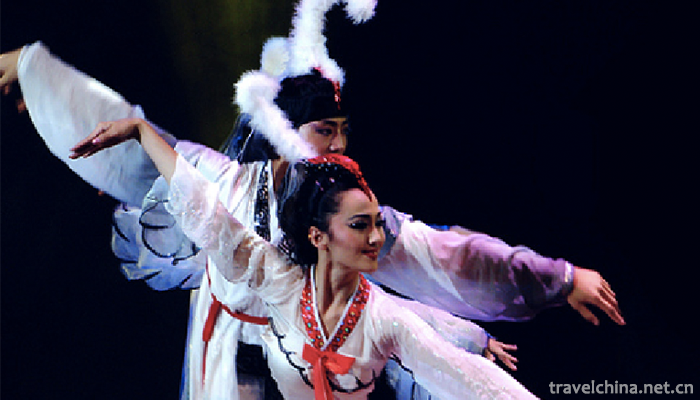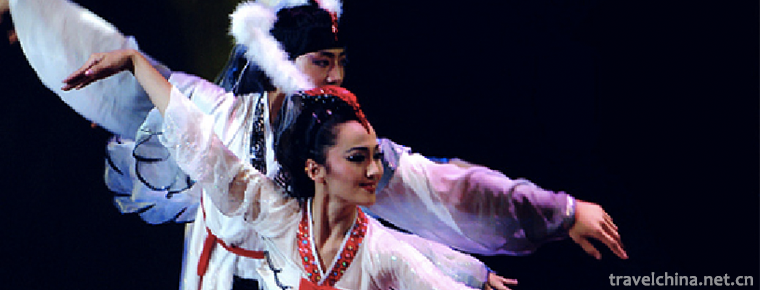Korean Crane Dance
Korean Crane Dance
Crane Dance of the Korean Nationality has a long history and is a unique dance performance form of the Korean Nationality in China. It has the national characteristics and the value of artistic research, has a very high reference value for the study of Korean dance in China, and has an important significance for enriching and improving the form of Chinese national dance.
Under the impact of modern culture, traditional culture is difficult to develop, professional performance opportunities are becoming less and less, and development is difficult. The talent who has the ability to perform and master the art of crane dancing is aging. The loss of backbone strength is serious. The old, middle, young and young talents are out of file, and the green and yellow are not connected. As a result, crane dancing is facing endangerment.
In June 2008, the Korean Crane Dance declared by Yanbian Korean Autonomous Prefecture of Jilin Province was listed in the second batch of national intangible cultural heritage list with the approval of the State Council. Heritage serial number: 655 III-58.
historical origin
Korean folk dance is formed on the basis of the traditional culture of ancient Korea, Fuyu, Koguryo and Sankorea. Chinese Korean folk dance, on the basis of Korean traditional culture, forms today's dance charm in the specific historical environment of Northeast China. To study Korean folk dance culture, we should understand the economic life, national psychology and the historical aspects of its ancestors, further study the evolution and development after becoming Korean, and analyze the cultural characteristics and remains of material and spiritual in various stages of development. Korean folk dance has become a high-level artistic form with Chinese national characteristics in a wide range of collections.
The Korean nation has a long tradition of music and dance, which has a profound historical accumulation and cultural connotation. Therefore, whether in the Tang, Song Dynasty or after the cultural input, they can absorb foreign forms of music and dance extensively, maintain their own cultural tradition and make it develop continuously. Because of the mutual influence between the "music and dance" of the court and the "folk music", the national color of folk dance has been enhanced correspondingly, and the ancient custom of singing and dancing is still prevalent.
The rhythm of Korean folk dance, the embodiment of crane's mentality in folk dance, is the integration of inherent beauty and dance posture beauty of the Korean nation. It is the result of the coordination and sublimation of the unique rhythm form and breathing method to show their mentality and charm of worshiping cranes. In Korean folk dances, the material factors that simulate the natural form of cranes are "Hebu" and "Hefei" dancing images. Stilts seem to have nothing to do with cranes and Korean folk dances, but in the book Gaogouli Culture, there are acrobatic portraits of stilts on the murals of opera figures in the ancient graves of Baqingli and Shuishan, which is a visual simulation of the ancient Korean crane totem worship.
artistic characteristics
The Korean Crane Dance was originally an interlude performance form of the large-scale court song and dance "Five Prescriptions Dance". During the Li Dynasty, there were new changes in the performance of crane dance: two cranes danced around two lotus flowers and became an independent "Heli Lotus Dance". Crane Dance has been introduced into China for a hundred years. It has been processed and reorganized by folk artists to make it more perfect and popular among the people. At the beginning of liberation, it was popularized in all counties and cities in Yanbian area, and at present it is the most widely popularized in Antu.
Under the beautiful Changbai Mountain, the white and elegant crane is the symbol of auspiciousness, purity and longevity in the hearts of the Korean people. Its graceful form and beautiful characteristics vividly reflect the Korean folk dance, thus forming a dynamic and static combination, relaxed, free and flowing, graceful and graceful dance features, "crane foot" and "crane flying" are common dance images of the Korean nationality. Korean experts once described their own national dance in this way: crane-like pace and willow-like body, this summary is very accurate and refined.
The Crane Dance mainly simulates the crane's leisurely movements, such as neck-lifting, pecking and arm-swinging, to show the Korean people's spiritual belief in revering cranes and their pursuit of goodness and beauty. It is the only bird masquerade dance in Korean folk dance. The movement is marked by the imitation of crane characteristics. It is simple, gentle and stretching. It is a special form of artistic performance, which is obviously different from other Korean dances.
Inheritance and protection
In 1952, Jin Zaoshan, the first generation inheritor of crane dance, performed the "crane dance" at the amateur literary performance of farmers in Wanbao Town (now Wanbao Town). In the 1980s, the "crane dance" was spread through the excavation and arrangement of literary and artistic workers. In 1989, the Antu County delegation performed the "crane dance" and won the first prize in the whole state literary and artistic performance. In 1997, the "crane dance" was earned by the government. "Chinese Korean Dance Integration" edited by the Ministry of Family Culture.
"Crane Dance" has a high artistic and ornamental quality. Antu County, aiming at the lack of professionals and the low level of relevant theoretical research, allocated special funds to establish a performance base, set up a Korean art training center, and put "Crane Dance" as the focus of training content. At the same time, the intangible cultural heritage at the national level has been declared.
In the future, Antu County will also set up a dance troupe with "Crane Dance" as its main content in the tourist attractions, and build a folk culture system with the focus on Crane Dance, so as to make the folk cultural heritage art of this nationality develop continuously.


-
1.Qinhuangdao Shanhaiguan Scenic Area
Shanhaiguan, also known as Yuguan, Yuguan and Linluguan, is located 15 kilometers northeast of Qinhuangdao City, Hebei Province
Time 2018-11-24 -
2.Fenghuangling Natural Scenic Park
Beijing Fenghuangling Natural Scenic Park is China's National AAAA Scenic Area. The scenic spot is located in the northwest of Haidian District, 51 kilometers away from Tiananmen straight line
Time 2018-12-26 -
3.Production Techniques of Buyi Medical Herbs for Benefiting Liver
Guiding County, Guizhou Province, is a subtropical monsoon rheumatic fever climate with distinct seasons, rich heat, long frost-free period, abundant rainfall and complex and
Time 2019-04-04 -
4.Chaohu folk songs
Chaohu Folk Song, the local traditional music of Chaohu City, Anhui Province, is one of the national intangible cultural heritage. On May 20, 2006, Chaohu
Time 2019-04-16 -
5.Brewing Techniques of Sufu
Sufu brewing technology, the traditional technology of Haidian District, Beijing, is one of the national intangible cultural heritage.
Time 2019-04-30 -
6.72 Sorcery Music of Lingyun Zhuang Nationality
The 72 witchcraft tunes of Lingyun Zhuang nationality originated in Lingyun County, Guangxi, mainly centered on Sicheng Town, where the county government is located. It is a tune sung by the Zhuang wi
Time 2019-05-13 -
7.Legend of Lugou Bridge
The legend of Lugou Bridge is very rich in content, including the construction of Lugou Bridge, the lion on Lugou Bridge, Lugou pier chopping dragon and sword, Lugou Xiaoyue, Lugou Bridge and Wanping
Time 2019-05-15 -
8.temple fair
Temple fair, also known as "temple market" or "festival venue". It is a Chinese folk religion and the custom of the age. It is usually held on the Lunar New Year, the Lantern Festi
Time 2019-06-05 -
9.Weaving and Dyeing Techniques of Uygur Felts and Printed Fabrics
Uygur felt, printing and dyeing technology, Xinjiang Uygur Autonomous Region Turpan (now Turpan) local traditional skills, one of the national intangible cultural heritage.
Time 2019-06-26 -
10.Wuzuquan
Wuzu Quan is one of the Nanquan in traditional Chinese boxing. It is said that Cai Yuming (from Quanzhou, Fujian Province, 1853-1910) synthesized Baihe Quan, Monkey Quan, Arhat Quan, Dazun Quan and Ta
Time 2019-06-29 -
11.History and culture of Mianyang
Located 47 kilometers south of Santai County, Qijiang ancient town was once the capital of Qi state during the spring and Autumn period and the Warring States period. Every year on the 27 to 28 May of the lunar calendar, all the male and female believers around
Time 2020-12-14 -
12.Nanchong Education
By the end of 2019, there were 271 primary schools in Nanchong, with 57000 students enrolled and 356700 students in school. The enrollment rate of primary school-age children was 100%. There are 427 junior high schools with 62900 students and 185300 students in school.
Time 2020-12-17